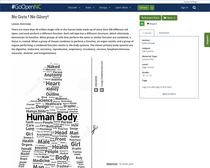Description
- Overview:
- There are more than 50 trillion single cells in the human body made up of more than 200 different cell types, and each perform a different function. Each cell type has a different structure, which ultimately determines its function. When groups of cells that perform the same or similar function are combined, a tissue is created. When a group of tissues combines to perform a function, an organ results; and a group of organs performing a combined function results in the body systems. The eleven primary body systems are the digestive, endocrine, excretory, reproductive, respiratory, circulatory, nervous, lymphatic/immune, muscular, skeletal, and integumentary.Objective: To assess your knowledge of the human body prior to taking this course. You will revisit your life-size human body poster at the end of the year!
- Subject:
- Life Science
- Level:
- High School
- Grades:
- Grade 10, Grade 11, Grade 12
- Material Type:
- Lesson Plan
- Author:
- Kathy Bosiak
- Date Added:
- 11/28/2019
- License:
-
Creative Commons Attribution Non-Commercial Share Alike

- Language:
- English
- Media Format:
- Interactive
Standards
Evaluations
No evaluations yet.


Comments